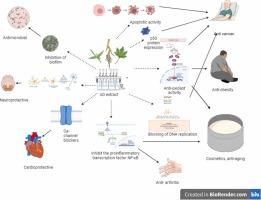Pharmacological applications of Urtica dioica: a comprehensive review of its traditional use and modern scientific evidence
IF 2.2
4区 医学
Q2 INTEGRATIVE & COMPLEMENTARY MEDICINE
引用次数: 0
Abstract
Introduction
This review article provides a comprehensive overview of the phytochemical constituents, traditional uses, and pharmacological applications of Urtica dioica (UD), commonly known as stinging nettle.
Methodology
An extensive literature search was conducted to identify 278 relevant articles. After eliminating 38 duplicates, we thoroughly analysed the remaining 240 articles by examining their titles and abstracts. Finally, 126 articles were selected for inclusion in this comprehensive study on UD.
Discussion
This review explores the plant identifiable characteristics, geographical distribution and taxonomic classification. The phytochemicals found in plants include sterols, fatty acids, alkaloids, terpenoids, flavonoids, lignans, and essential oils, all of which contribute to their medicinal and therapeutic properties. It exhibits a broad range of pharmacological activities including anti-inflammatory, hypoglycaemic, antiurolithiatic, neuroprotective, antioxidant, antimicrobial, antiproliferative, and anticancer effects. UD leaves contain high levels of antioxidants, which may be useful for the treatment of breast cancer by inducing apoptosis. UD extracts exert a protective function by regulating blood glucose levels and β-cell activity, exhibiting insulin-like effects. It also inhibits pro-inflammatory pathways and demonstrates hepatoprotective properties following hepatectomy. UD extract inhibits the proliferation and migration of cancer cells and displays antiviral activity against rotavirus and feline immunodeficiency virus. Furthermore, UD is effective in treating chronic conditions, such as prostatitis, dandruff, and osteoarthritis, thereby reducing the need for conventional medications.
Conclusion
The diverse uses and biological properties of UD make it a subject of interest for future research.

荨麻的药理应用:对其传统用途和现代科学依据的全面回顾
引言 这篇综述文章全面概述了荨麻(俗称刺荨麻)的植物化学成分、传统用途和药理应用。方法 通过广泛的文献检索,我们找到了 278 篇相关文章。在剔除了 38 篇重复文章后,我们对剩余的 240 篇文章的标题和摘要进行了深入分析。讨论本综述探讨了植物的可识别特征、地理分布和分类学分类。植物中的植物化学物质包括甾醇、脂肪酸、生物碱、萜类化合物、黄酮类化合物、木脂素和精油,所有这些物质都有助于提高植物的药用和治疗特性。它具有广泛的药理活性,包括抗炎、降血糖、抗尿酸盐、神经保护、抗氧化、抗菌、抗增殖和抗癌作用。UD 叶子含有大量抗氧化剂,可通过诱导细胞凋亡治疗乳腺癌。UD 提取物通过调节血糖水平和 β 细胞活性发挥保护功能,具有类似胰岛素的作用。它还能抑制促炎途径,并在肝切除术后显示出保护肝脏的特性。UD 提取物能抑制癌细胞的增殖和迁移,并对轮状病毒和猫免疫缺陷病毒具有抗病毒活性。此外,UD 还能有效治疗慢性疾病,如前列腺炎、头皮屑和骨关节炎,从而减少对传统药物的需求。
本文章由计算机程序翻译,如有差异,请以英文原文为准。
求助全文
约1分钟内获得全文
求助全文
来源期刊

Journal of Herbal Medicine
INTEGRATIVE & COMPLEMENTARY MEDICINE-
CiteScore
3.90
自引率
0.00%
发文量
94
期刊介绍:
The Journal of Herbal Medicine, the official journal of the National Institute of Medical Herbalists, is a peer reviewed journal which aims to serve its readers as an authoritative resource on the profession and practice of herbal medicine. The content areas of the journal reflect the interests of Medical Herbalists and other health professionals interested in the clinical and professional application of botanical medicines. The objective is to strengthen the research and educational base of herbal medicine with research papers in the form of case studies, original research articles and reviews, monographs, clinical trials and relevant in vitro studies. It also publishes policy statements, opinion pieces, book reviews, conference proceedings and profession related information such as pharmacovigilance reports providing an information source for not only the Herbal Practitioner but any Health professional with an interest in phytotherapy.
 求助内容:
求助内容: 应助结果提醒方式:
应助结果提醒方式:


